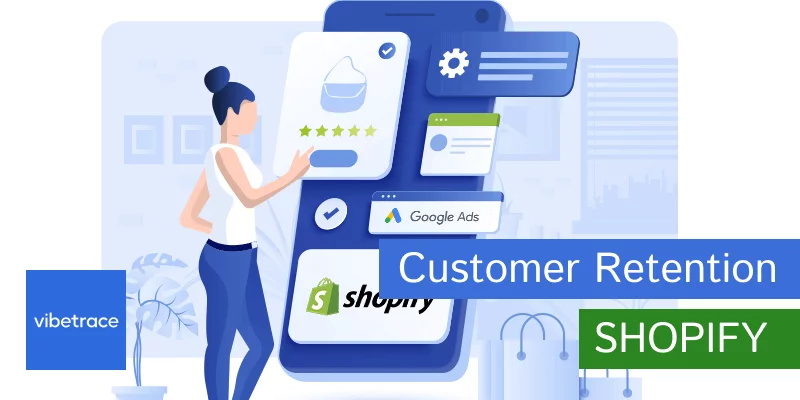We’ve stated on multiple occasions that it’s cheaper to convert existing traffic and make existing customers complete a repeat purchase than to attract new ones.
That’s especially true for the retail field and highly competitive e-commerce businesses. And such a business might run on Shopify.
This article is part of a bigger topic where we help Shopify owners grow their business.
To battle the increasing costs of conversions, use tactics and strategies that can boost the so-called retention rate. Customer retention combines results with creativity.
If you’re not trying to re-engage customers and nurture relationships, now’s the time to start doing it. This article will introduce you to customer retention, but most importantly, it will provide you with 9 proven-to-work ways to boost the retention rate.
The best part? You can start applying these methods right away. Let’s see them!
What is Customer Retention Rate?
The customer retention rate is directly proportional to your efforts to nurture relationships and engage existing customers to make them return.
To score a high customer retention rate, you’ll need to ensure your customers’ satisfaction and encourage repeat-purchase behavior.
Customer retention plays an essential role in successful businesses. You invest time and money to acquire customers.
If you successfully prevent them from turning to the competition, you can consider your Shopify store successful.
What is your customer retention? To find out, consider 3 variables:
- number of customers at the start of a particular period;
- number of customers at its end;
- number of new customers acquired during it.
As a result, you can get the following formula:
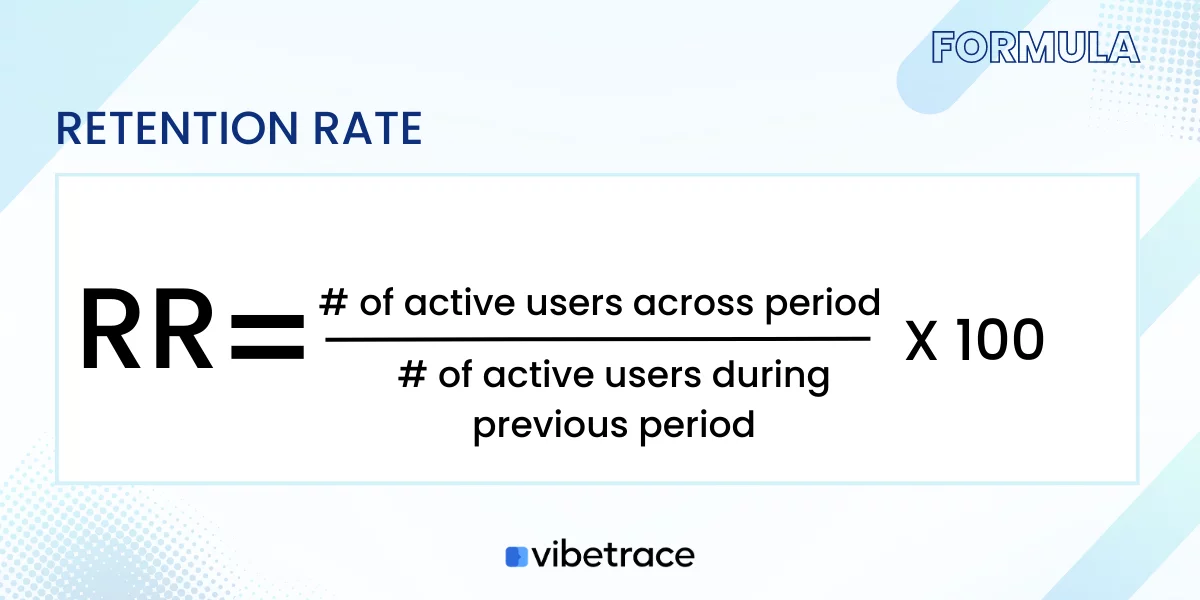
Let’s take an example. Consider the second half of 2022 and say you had 4 000 customers at the start of July, acquired 500 new customers, and ended the year with 4 200. Your six-month retention rate would be:
[(4 200 – 500) / 4 000] * 100 = 0.925 * 100 = 92.5% CRR.
In other words, 9 out of 10 customers made a repeat purchase in the second half of 2022, and your business is doing incredibly well.
What’s behind those outstanding numbers, and if you can’t achieve them, what might be the reason for that? We’ll explore that below!
What Affects Customer Retention Rate?

On average, CRR in the retail industry gravitates around 60-65%. Numerous things affect it, like trust, credibility, support, price, convenience, and customer and post-purchase services. Those impact the first major factor that will determine your customer retention rate:
1. Are Customers Satisfied?
If the answer’s No, they won’t return. You can actively measure satisfaction through surveys and by gathering feedback, and act to increase it. Do keep in mind that even if you actively try to improve customer retention, some still might leave because of other reasons like price and convenience of purchase.
That’s because you probably operate in a competitive market, and your goods most likely lack one specific characteristic that we’ll discuss next.
2. Are Your Goods Essential?
If the answer’s No, customers are likely to leave. People return regularly only to businesses that provide essential or niche goods and services with no or few alternatives.
If you’re in retail, the competition will be huge, and you’ll have to ensure customer satisfaction if you want to achieve high CRR. To help with that, below, we’ll outline some key metrics to consider when thinking about customer retention and improving it.
Metrics to Consider
Several underlying metrics will help you build an efficient CRR strategy once you start monitoring them. These include:
- Repeat Customer Rate – the percentage rate of customers making repeat purchases. Measure this alongside CRR to see how your customer retention strategy performs. Divide the repeat-purchase customers by unique customers to get it.
- Average Order Value – or AOV, to know how much individual customers spend on your Shopify store. You can get the AOV by dividing the total revenue for a specific period by the number of orders for that particular period. Once you’re aware of the AOV, you can start working towards increasing it.
- Purchase Frequency – or how often customers purchase again. Divide the number of placed orders by the unique customers for a particular period, and you’ll see how frequently repeat purchases happen.
- Customer Lifetime Value – or CLV helps you understand each customer’s value. CLV increases with boosting customer retention, and when you calculate it, you can get actionable insights into your customers’ buying behavior, so that you can start making efforts to boost CLV. It’s the product of AOV and Purchase Frequency.
- Churn Rate – those are customers lost during a particular period, and the metric might give you an insight into why that happened. The formula is similar to that of CRR: [(S – E) / S] * 100
When you consider these metrics, you can use the data to inform the strategies you’ll be using to increase the CRR on your Shopify store.
Below, we’ll explore such efficient strategies in more detail, along with specific Shopify apps that can help you execute them, so keep reading if you want to improve your CRR.
Want to be up to date with Marketing?
Subscribe to our Retail CX newsletter!

Stay connected with what’s really important to optimize your digital revenues.
By clicking the button, you accept our Terms & Conditions. Also you will need to confirm your email address.
9 Strategies to Boost Customer Retention Rate
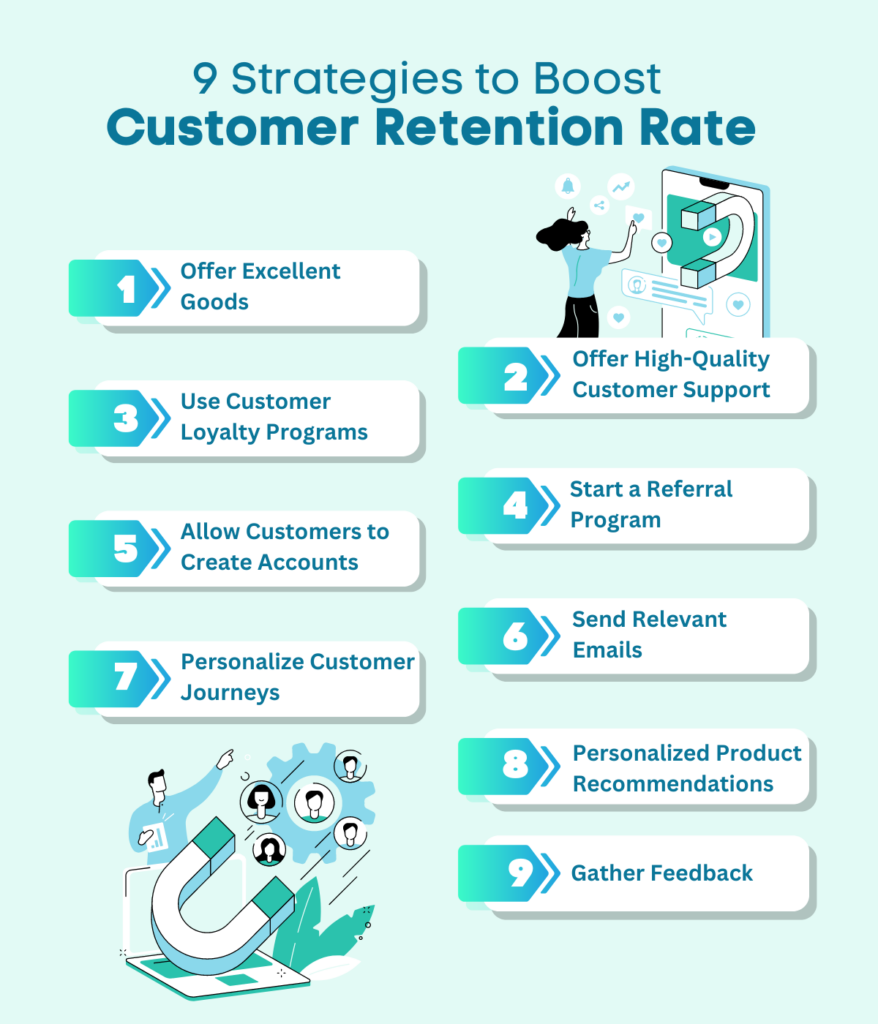
Use these strategies for your Shopify store.
You already know that the average CRR of e-commerce is around 65%. Not a lot, at a glance, but when you consider that retail doesn’t offer essential goods, and the competition is massive, it’s still significant.
If the customer retention rate on your Shopify store is nowhere near that, or you want to test some ideas to see if you can boost it above that, here are 9 strategies you can use:
1. Offer Excellent Goods
If you regularly deliver low-quality or damaged goods, don’t expect high CRR. As customers, we’ve been spoilt for choice. Unless you’re in the market for unique or very niche goods, people won’t purchase again if your products aren’t of high enough quality.
Price is often an indication of quality. If you put a high price tag on your goods, ensure you provide the corresponding quality. If it’s lower, you still might have a high CRR, if you put the right price tag on it.
That’s of the utmost importance especially when you’re dropshipping with apps like Zendrop, DSers, and Spocket.
2. Offer High-Quality Customer Support
High-quality customer support often plays a huge part in high CRR. People might have questions regarding the delivery, might want to take advantage of your return policy but can’t understand it, or have any inquiries that might come to mind.
To make the customer journey pleasant and leave people satisfied, make yourself available. For example, use a live chat option with apps like Tidio, which even gives you the option to use a chatbot. Answering customers’ questions at the right moment might make the difference between converting and bouncing.
3. Use Customer Loyalty Programs
As a consumer, you’ve probably come across those yourself. They’re often dubbed as Customer Retention Programs, and that’s one of their main goals.
Loyalty Programs involve customers with your brand and help build a strong relationship. The rewards in such programs often encourage customers to make repeat purchases to get them.
Those incentives can be anything from sizable discounts to exclusive coupons and even free shipping. Customer Loyalty Programs also make customers feel special, and when they’re more involved with your brand, it will be harder for them to leave.
You can easily launch such programs with apps like Yotpo and Growave.
4. Start a Referral Program
Referral Programs are very similar to Customer Loyalty Programs, but they go a step further. Through Referral Programs, you can boost customer retention AND gain new customers that you can later work on retaining and nurturing.
Referral Programs create brand ambassadors, and you can work toward creating those with apps like UpPromote and Referral Candy. What you need to focus on is creating a tempting incentive. You can choose to make it applicable to both your current and new customers.
A great example of a referral program incentive can be a $25 discount on the existing customer’s next purchase if the person they refer makes a purchase. Make that even more attractive by giving their friend a 25% off their first purchase. That way, everybody wins, your referral program offer is worthwhile, and existing customers have a strong incentive to make repeat purchases.
5. Allow Customers to Create Accounts
Accounts can make customers’ lives easier. They allow them to store shipping information, a history of purchases made, and even a Wishlist or a list of Favorites. Allow visitors to purchase without an account, but also give them the option to create one.
You want to cover all your bases regarding convenience. By using customer accounts and apps like Wishlist Plus, Wishlist Hero, and Wishify to allow the creation of lists, people can easily repurchase products they love and keep track of those they’re considering. Additionally, accounts provide information and insights into customer behavior.
That, in turn, helps you better analyze and segment your audience. As a result, you can create enhanced customer journeys and make more relevant product recommendations in your campaigns to boost your CRR.
That brings me to several prominent customer retention strategies regarding personalization.
6. Send Relevant Emails
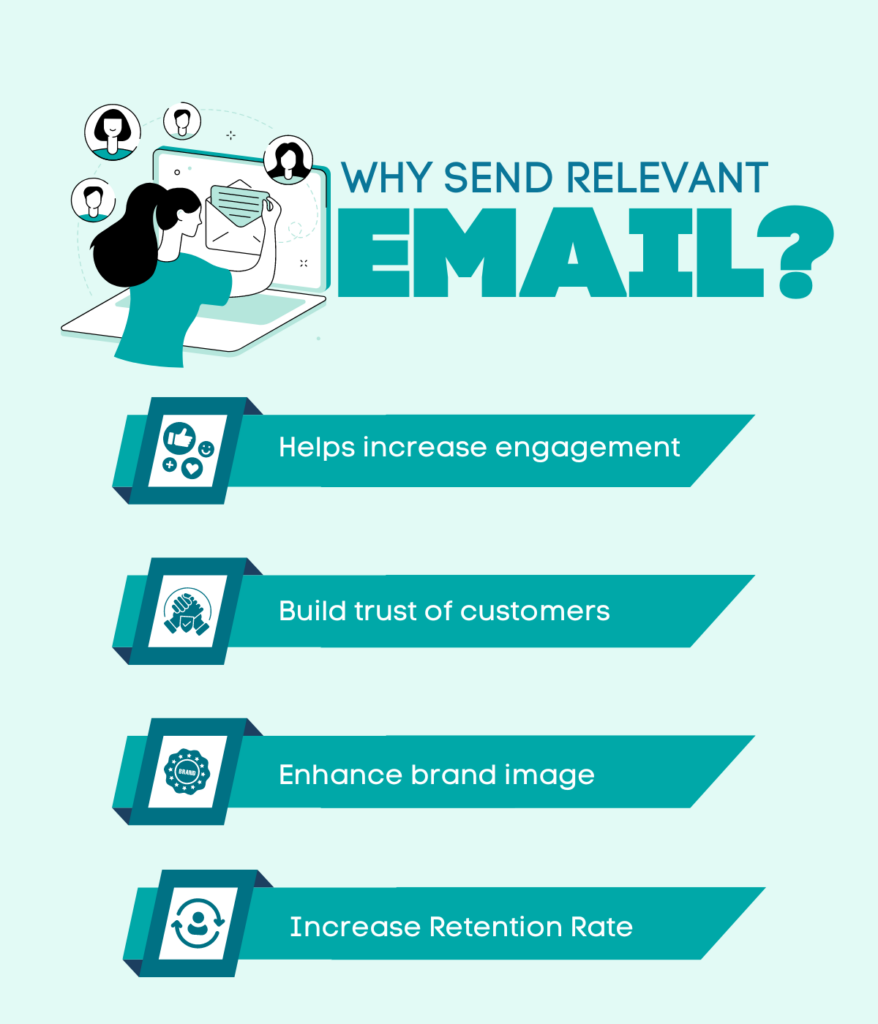
Email marketing might be the oldest tool in the shed of digital marketing. Most importantly, it’s probably the sharpest when it comes to customer retention. By analyzing and segmenting your audience, you can stay relevant with every email you send.
We all receive dozens, if not hundreds of promotional emails every day, and getting coupons and discounts is nothing new. As a marketer, try to find a meaningful angle to explore.
Send a 10% discount for the last ten products viewed or 20% for the products in an abandoned cart, for example.
By keeping your promotional emails relevant to your customers’ interests and aligned with their buying behavior, your incentives will work better toward encouraging repeat purchases.
7. Personalize Customer Journeys
Customer journeys aren’t linear. People might visit your website, browse through their phone or desktop, open an email, click through from another, jump to your social media accounts to see if you have announcements for new arrivals or discounts, and so on.
A customer journey has plenty of twists and turns. To incentivize existing customers to purchase again, you must personalize your communication at every touchpoint. That increases conversion rates and also shows customers that you’re paying attention.
As a result, you’ll boost customer satisfaction and make it harder for people to abandon you for the competition.
8. Personalized Product Recommendations
One of the best ways to create personalized customer journeys, apart from adapting your communication and messages, is through personalized product recommendations with apps like VibeTrace and Also Bought. Those can help you with:
- Bringing attention to new arrivals;
- Cross-selling existing customers;
- Upselling them for higher AOV.
If you’re not using personalization in your marketing campaigns, now’s the time to start. It requires the so-called product recommendations engines that use AI and robust ML algorithms to analyze customer behavior and recommend the products most relevant to their needs and desires.
In the end, you can expect to create a wholesome, delightful experience.
How to be sure you’re succeeding? That’s where the last, but not the least important strategy for boosting CRR comes into play.
9. Gather Feedback
A decreasing CRR indicates people have found something better somewhere else. Whether it’s better products, improved customer support, or more attractive offers and programs, you can only guess.
Unless you ask your customers. But don’t wait until you see poor customer retention. Involve customers from the start, from the moment they make their first purchase. Use post-purchase surveys from apps like Fairing, Zigpoll, and Grapevine to ask about customer experience on your store and what improvements could be made.
Show customers that they’re more than a conversion by involving them. Just like Customer Loyalty and Referral programs make them feel involved, help them be heard by actively seeking their feedback.
To Wrap Up
You might be asking yourself if all this is worth it. I want to remind you that it’s cheaper to nurture repeat-purchase behavior than to try to convert first-time visitors. Your greatest asset is your existing customer base – treat it like that.
With robust apps like VibeTrace, you can apply powerful customer retention strategies that boost revenues and accelerate growth. All by simply getting to know your customers better and using that knowledge to enhance their experience.
Don’t waste more time and miss out on sales, and start developing your customer retention strategy today. Make it a priority, and acquire the desired results.
Mentioned Apps:
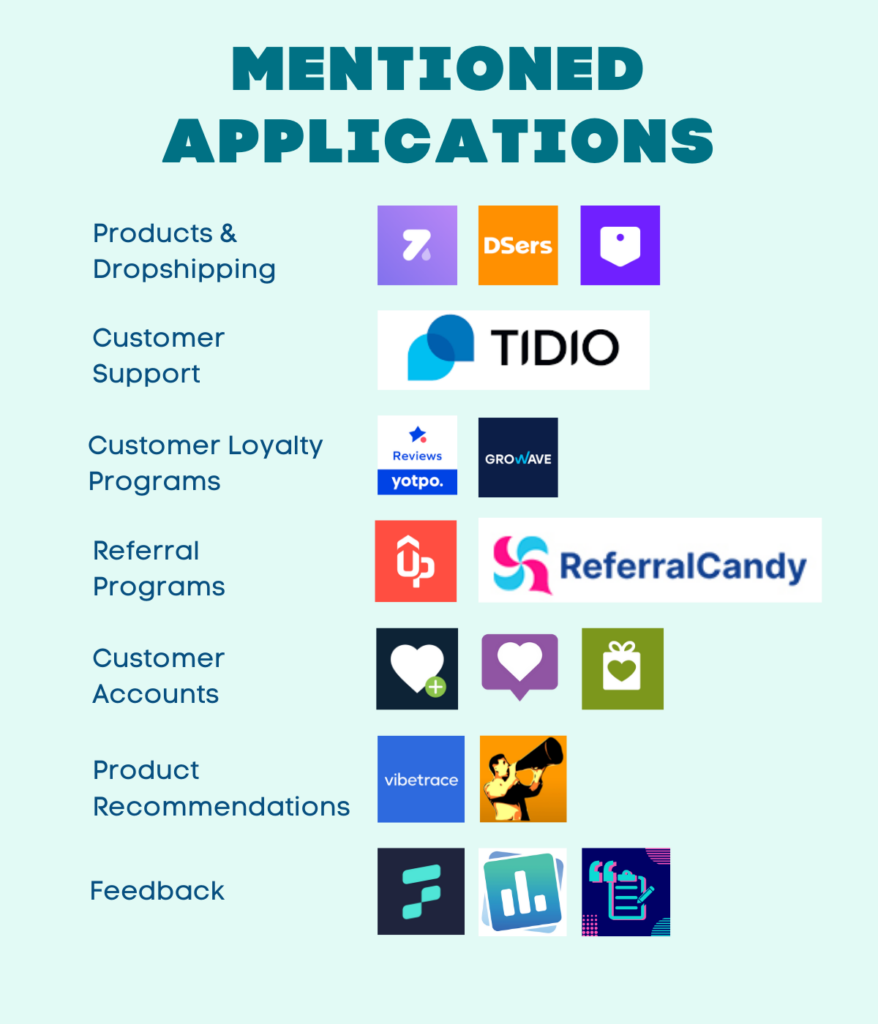
Products & Dropshipping – Zendrop, DSers, Spocket
Customer Support – Tidio
Customer Loyalty Programs – Yotpo, Growave
Referral Programs – UpPromote, Referral Candy
Customer Accounts – Wishlist Plus, Wishlist Hero, Wishify
Product Recommendations – VibeTrace, Also Bought

